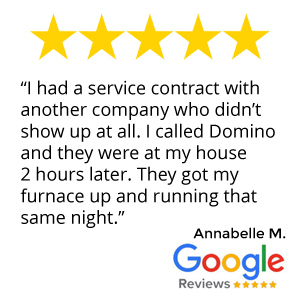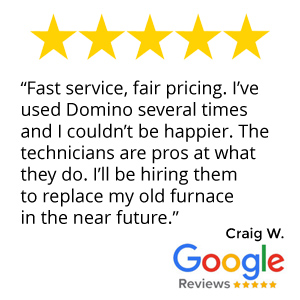Schedule Your Furnace Repair Today – Call or Fill Our Form Below
What Our Customers Have to Say



Furnace Repair Cost on Long Island
When addressing furnace repair, it is vital to grasp the fundamentals of how the heating system operates, to diagnose common issues and to understand each part’s role in the appliance’s function.
The average furnace repair cost on Long Island ranges from $200 to $350, with more complex repairs running $500+. Some key factors that influence furnace repair costs include:
- Type of Repair Needed – Minor repairs like blower motor replacement average $200-300. More involved issues like heat exchanger replacement can be $500+.
- Labor Rates & Time – HVAC repair techs charge $75-$150/hour on Long Island. Labor for complex repairs takes more time, raising costs.
- Furnace Age & Model – Repairs on newer mid/high-efficiency models cost more given their complexity. But they tend to require fewer repairs overall.
- Emergency Service Charges – After hours or weekend emergency furnace repairs often incur an additional $100-$250 surcharge.
- Parts Costs – Component parts like circuit boards, igniters and inducer motors can range from $50 up to $1000+ depending on the make and model.
Getting an accurate diagnosis from a licensed HVAC technician is recommended to understand what is required and the expected overall investment based on your specific furnace make, model and issues observed. But on average, most furnace repairs on Long Island fall between $200 to $500 based on typical issues the area sees.

Basics of Furnace Operation
A furnace is a key appliance within an HVAC system that provides heat to a residence or business. It operates by drawing in air, heating it via a heat exchanger, and then distributing the warm air through the ductwork. Thermostats are used to set desired temperatures and control the furnace’s cycle.
Common Furnace Problems and Solutions
Many furnace repairs relate to a handful of problems:
- Noisy Furnace: Can indicate airflow reductions, a clogged burner, or mechanical issues. Solutions may range from filter replacement to component adjustment or repair.
- Furnace Not Heating: Causes include a faulty thermostat, extinguished pilot light, or a malfunctioning limit switch. Troubleshooting should start with checking the thermostat and pilot light before examining electrical components.
- Blower Continuously Running: This issue may stem from a problem with the limit switch which might necessitate recalibration or replacement.
Identifying Furnace Parts and Their Functions
Understanding various furnace parts is crucial for troubleshooting:
- Thermostat: Communicates desired temperature levels to the furnace.
- Heat Exchanger: Heats up the air without mixing combustion gases with the household air.
- Blower Motor: Propels air through the heat exchanger and into the ductwork.
- Limit Switch: Prevents overheating by shutting down the furnace when internal temperatures exceed safety levels.
Proper maintenance and timely repairs are paramount in ensuring the longevity and efficiency of furnaces within HVAC systems.
Furnace Repair Services and Support
When it comes to furnace repair, homeowners should consider the expertise of the service provider, warranty coverage, and whether to opt for professional services or undertake repairs themselves.
Choosing the Right Repair Service Provider
Selecting a reputable HVAC service for furnace repair is crucial. Homeowners should look for providers with certified technicians who have a track record of honest and reliable service. Domino can perform an in-depth assessment of both the home and the existing system, which could include furnace repair as part of their overall home services. Checking reviews can also aid in making an informed decision, ensuring that you’re choosing a service that balances quality and cost-effectiveness.
Understanding Warranty and Support Options
Warranty coverage is an important factor when dealing with furnace repair. Homeowners should review their system’s warranty to understand what is covered in terms of parts and labor. Many brands offer extended warranties and support options, which can provide additional peace of mind.
Navigating Repairs: DIY vs. Professional
Deciding between DIY furnace repair and hiring a professional hinges on the complexity of the problem and the homeowner’s technical expertise. For simple filter changes or thermostat issues, DIY might be a suitable option. However, more complex issues like repairing internal components or handling gas lines should be addressed by a professional service provider. For those who opt for professional help, services like those found through a local furnace service can provide 24/7 support, ensuring that help is available whenever it’s needed, including for air conditioning concerns.
Remember, routine maintenance from a qualified technician can help prevent the need for urgent repairs and can significantly reduce long-term costs by ensuring the furnace runs efficiently.
Enhancing Furnace Performance and Safety
Maintaining peak performance and ensuring the safety of your furnace are critical to home comfort and energy efficiency. This requires regular maintenance, timely upgrades to components, and adherence to safety best practices.
The Importance of Regular Maintenance
Regular maintenance is key to preserving both the performance and safety of a furnace. Homeowners should replace air filters regularly to prevent airflow restriction, which can strain the furnace and reduce efficiency.
Upgrading Furnace Components for Efficiency
Upgrading specific components of a furnace, such as the thermostat or blower motor, can lead to significant improvements in efficiency. A smart thermostat can automate temperature settings for optimal performance, while an energy-efficient blower motor can reduce electrical consumption.
Frequently Asked Questions
When it comes to furnace repair, homeowners often have questions regarding diagnosis, common part replacements, indicative signs of repair, causes of failure, costs, and professional service options. This section addresses these queries with precise, fact-based information.
How can I diagnose a problem with my furnace?
One could identify furnace issues by observing symptoms like lack of heat, unusual noises, frequent cycling, or the blower running continuously. To accurately diagnose, checking the thermostat settings, examining the filter for blockages, and ensuring the pilot light is on might be necessary steps.
Which parts of a furnace are most commonly replaced?
The most commonly replaced furnace parts typically include filters, ignitors, flame sensors, and thermostats. Regular wear and tear can cause these components to fail, necessitating replacement.
What signs indicate that my furnace needs repairs?
Noticeable signs such as insufficient heating, strange sounds, persistent odors, and increasing energy bills may indicate that one’s furnace requires repairs. If the furnace exhibits such signs, a professional inspection is advisable.
What could be the cause of a common furnace failure?
Common furnace failures can arise from a myriad of issues including clogged filters, ignition or pilot control problems, wear and tear, and malfunctioning thermostats. A condensation leak is a typical reason for high-efficiency furnaces leaking water.
How much should I expect to pay for furnace repairs?
The cost for furnace repairs can vary, but homeowners might expect to pay an average of around $300. The exact amount will depend on the nature of the problem and the parts required for the repair.
Who should I contact for professional furnace repair services?
For professional furnace repair services, one should reach out to a licensed HVAC technician or a reputable furnace repair company. Domino can provide comprehensive services ensuring the furnace operates safely and efficiently.
